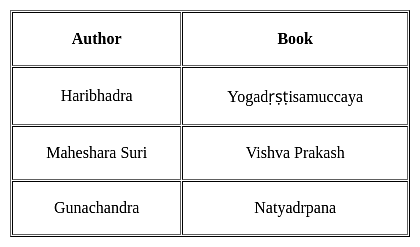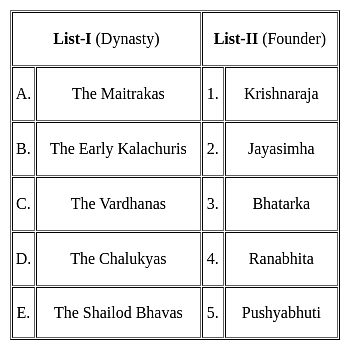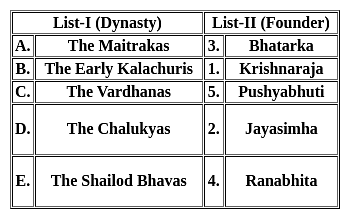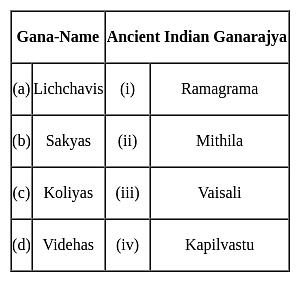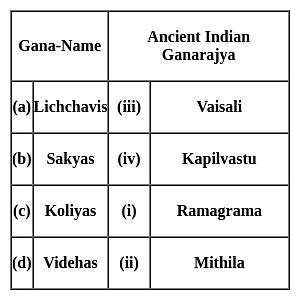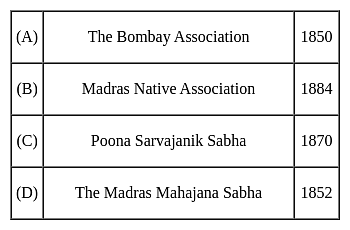APSET Paper 2 Mock Test - 10 (History) - AP TET MCQ
30 Questions MCQ Test - APSET Paper 2 Mock Test - 10 (History)
In the context of later Vedic age, read the following statement(s) and select those that may not be correct?
1. It cannot be said that the Vedic society shifted to East.
2. The Vedic society used iron technology mostly for weapons of war.
3. In agriculture only labour intensive technology was used.
4. People married outside their 'gotra'
Select the correct answer using the codes given below.
Which among the following was the primary cause of 1857 revolt?
| 1 Crore+ students have signed up on EduRev. Have you? Download the App |
Who is the author of Jain literature Kuvalayamala?
Consider the following statements with respect to the Sufi movement:
1. Sufism was a liberal reform movement within Islam
2. Sufism stressed the elements of love and devotion as an effective means of the realization of God.
3. Nizamuddin Auliya belonged to the Suhrawardi Order of Sufism.
Which of the statements given above is/are correct?
Match List I with List II, and select the correct answer by using the codes given below the lists:
List - I
I. Lingayats
II. Alwar
III. Nayanar
IV. Advaita
List - II
a. Andal
b. Karaikkal Ammaiyar
c. Basava
d. Shankara
Codes:
Who of the following was/were economic critic/critics of colonialism in India?
1) Dadabhai Naoroji
2) G. Subramaniya Iyer
3) R.C. Dutt
Select the correct answer using the codes given below:
With reference to Ryotwari Settlement, consider the following statements:
1) The rent was paid directly by the peasants to the Government.
2) The Government gave Pattas to the Ryots.
3) The lands were surveyed and assessed before being taxed.
Which of the statements given above is/are correct?
Which of the following was Samudragupta’s policy specifically towards the rulers of Dakshinapatha?
In which of the following areas are the beginning of settled life associated with a Chalcolithic rather than a Neolithic phase?
1. Rajasthan
2. Malwa
3. Northern Deccan
4. Gujarat
Select the correct answer using the codes given below
At which of the following places the entry of women as Bhikshuni into the sangha was allowed by Buddha?
Which of the following Muslim rulers abolished the pilgrimage tax?
The Regulating Act was passed in which year?
With reference to freedom struggle of India, consider the following statements of Swadeshi Movement:
1. In Rawalpindi (Punjab), the arsenal and railway workers went on strike led by Lala Lajpat Rai and Ajit Singh.
2. Subramania Siva and Chidambaram Pillai led strikes in Tuticorin and Tirunelveli in a foreign-owned cotton mill.
Which of the above statements is/are not correct?Which of the following is not correctly matched:
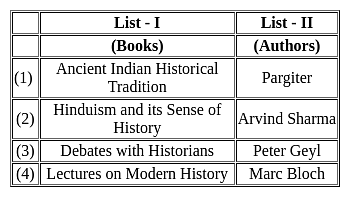
Which among the following recommendations of the Aitchison committee are correct?
- Maximum age of entry in civil service was fixed at 23
- Simultaneous examination in England and India should be stopped
- Two-tier classification of Civil Service would be replaced by a three-tier classification
- Statutory Civil Service should be abolished
Choose the correct option from the codes given below:
Consider the following statements regarding Fatehpur Sikri City:
1. The city was built by Mughal Emperor Akbar as a token of gratitude to Sheikh Salim Chisti.
2. The city is predominantly made up of Red Sand Stone.
3. It is a unique blend of Hindu and Islamic Architecture.
Which among the following above given statements are correct?
With reference to the Tilak’s Home Rule League, consider the following statements:
1. Tilak formed the league due to unhappiness towards Indian National Congress’s ineffective working.
2. Bombay was made as headquarter.
3. Education in Vernacular language and Swarajya were the important demands.
Which of the above statements is/are correct?Which one of the following did not form part of the Asokan empire?
With respect to medieval India, Consider the following pairs:
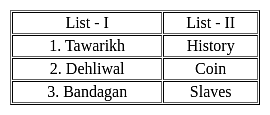
Which of the pairs given above are correctly matched?
Arrange the following Mughal emperors in chronological sequence:
(a) Farrukhsiyar
(b) Jahandar Shah
(c) Bahadur Shah
(d) Muhammad Shah
Select the correct option:
Which of the following is not a composition of Saint Tulsidas?


